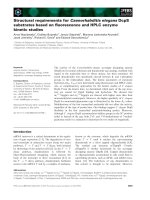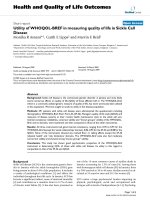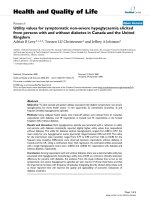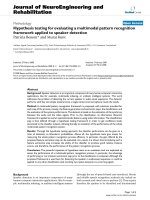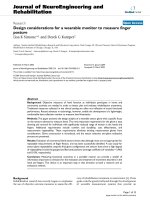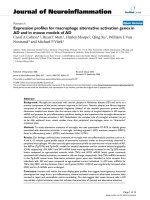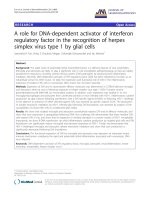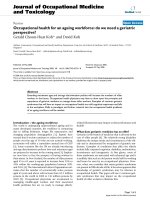báo cáo hóa học: " Utility values for symptomatic non-severe hypoglycaemia elicited from persons with and without diabetes in Canada and the United Kingdom" potx
Bạn đang xem bản rút gọn của tài liệu. Xem và tải ngay bản đầy đủ của tài liệu tại đây (221.29 KB, 8 trang )
BioMed Central
Page 1 of 8
(page number not for citation purposes)
Health and Quality of Life
Open Access
Research
Utility values for symptomatic non-severe hypoglycaemia elicited
from persons with and without diabetes in Canada and the United
Kingdom
Adrian R Levy*
1,2,3
, Torsten LU Christensen
4
and Jeffrey A Johnson
5
Address:
1
Oxford Outcomes Ltd., Vancouver, BC, Canada,
2
University of British Columbia, Vancouver, BC, Canada,
3
Centre for Health Evaluation
and Outcome Sciences, St Paul's Hospital, Vancouver, BC, Canada,
4
Novo Nordisk A/S, Denmark and
5
School of Public Health, University of
Alberta, Edmonton, Alberta, Canada
Email: Adrian R Levy* - ; Torsten LU Christensen - ;
Jeffrey A Johnson -
* Corresponding author
Abstract
Objective: To elicit societal and patient utilities associated with diabetic symptomatic non-severe
hypoglycaemia for three health states: 1) rare (quarterly), 2) intermittent (monthly), 3) and
frequent (weekly) hypoglycaemia episodes.
Methods: Using validated health states, time trade-off utilities were elicited from 51 Canadian
respondents with diabetes, and 79 respondents in Canada and 75 respondents in the United
Kingdom (UK) without diabetes.
Results and discussion: Each hypoglycaemic episode was associated with a reduction in utility
and persons with diabetes consistently reported slightly higher utility values than respondents
without diabetes. The utility for diabetes without hypoglycaemia ranged from 0.88 to 0.97, the
mean utility for rare hypoglycaemic events (quarterly) ranged between 0.85 and 0.94. The utility
for the intermittent state (monthly) ranged from 0.77 to 0.90 and from 0.66 to 0.0.83 for the
frequent state (weekly). Differences were observed between respondents without diabetes in
Canada and the UK. Using a multivariate linear OLS regression, the estimated utilities associated
with a single hypoglycaemic event were -0.0033 and -0.0032 for respondents with diabetes and
without diabetes, respectively.
Conclusion: Among respondents with and without diabetes, there was a demonstrable utility loss
associated with hypoglycaemia. Considering a utility loss of 0.03 as a minimum clinically important
difference for persons with diabetes, the evidence from this study indicates that as low as ten
symptomatic non-severe hypoglycaemic episodes per year may be of clinical importance and that
the importance increases with frequency of episodes. Integrating directly elicited utility values such
as those reported here will improve the quality and applicability of economic evaluations of
diabetes treatment.
Published: 29 September 2008
Health and Quality of Life Outcomes 2008, 6:73 doi:10.1186/1477-7525-6-73
Received: 10 March 2008
Accepted: 29 September 2008
This article is available from: />© 2008 Levy et al; licensee BioMed Central Ltd.
This is an Open Access article distributed under the terms of the Creative Commons Attribution License ( />),
which permits unrestricted use, distribution, and reproduction in any medium, provided the original work is properly cited.
Health and Quality of Life Outcomes 2008, 6:73 />Page 2 of 8
(page number not for citation purposes)
Background
Hypoglycaemia is a common unintended consequence of
insulin that ranges from being bothersome to resulting in
coma or even death among persons with diabetes. One
group of investigators in the United Kingdom (UK)
reported that 73% of insulin users who responded to a
mail survey reported at least one hypoglycaemic episode
in the past three months [1]. Weekly rates of hypoglycae-
mic episodes have been estimated at 0.82 and 0.33 for
persons with Type 1 and insulin-treated Type 2 diabetes,
respectively [2].
While most hypoglycaemic episodes are relatively benign
and can be remedied by eating fast-acting carbohydrates,
severe episodes – requiring the assistance of others – can
result in unconsciousness, seizure, coma and even death.
Symptoms of hypoglycaemia can include palpitations,
tremor, hunger, and sweating. These can be accompanied
by behavioural changes, cognitive impairments, or frank
confusion, and can, in severe cases, include seizure, coma,
and even death [3].
The American Diabetes Association defines five categories
of hypoglycaemia episodes [3]: severe (an event requiring
assistance of another person to actively administer carbo-
hydrate, glucagons, or other resuscitative actions); docu-
mented symptomatic episodes (an event during which typical
symptoms of hypoglycaemia are accompanied by a meas-
ured plasma glucose concentration ≤ 70 mg/dl (3.9
mmol/l)); asymptomatic episodes (an event not accompa-
nied by typical symptoms of hypoglycaemia but with a
measured plasma glucose concentration ≤ 70 mg/dl (3.9
mmol/l)); probable symptomatic episodes (an event during
which symptoms of hypoglycaemia are not accompanied
by a plasma glucose determination but that was presuma-
bly caused by a plasma glucose concentration ≤ 70 mg/dl
(3.9 mmol/l)); and relative episodes (an event during
which the person with diabetes reports any of the typical
symptoms of hypoglycaemia, and interprets those as
indicative of hypoglycaemia, but with a measured plasma
glucose concentration > 70 mg/dl (3.9 mmol/l)).
Hypoglycaemia can have two types of effects on health
related quality of life (HRQOL): the short-term conse-
quences of the episode itself and long-term consequences
related to behavioural changes and fear of future episodes.
The short-term consequences include the unpleasant
symptoms related with the actual episodes. The risks of
hypoglycaemia are highlighted by dangerous situations
that can arise while the patient is hypoglycaemic (e.g.
while driving). For example, recently, one of the largest
settlements in Canadian legal history was awarded after a
person with diabetes suffered a hypoglycaemic episode
while driving a car, passed out, and veered into oncoming
traffic which led to the death of another driver [4].
The long-term consequences of hypoglycaemia include
negative social and emotional sequelae which may make
patients reluctant to intensify insulin therapy [5]. The
long-term consequences can also include a pattern of fear
of hypoglycaemia with negative impact on patients'
HRQOL [6]. Qualitative studies on fear of hypoglycaemia
relate this fear to loss of control, unpredictability, danger,
and interpersonal conflict [7]. This impact can be substan-
tial for both patients and caregivers [1,8,9]. Patients suf-
fering hypoglycaemic episodes are more prone to anxiety
and panic attacks and these sequelae increase with the
number of episodes [10,11]. In order to avoid hypogly-
caemic events, some patients alter insulin treatment inten-
sity and others may engage in behaviours like overeating
which are designed to elevate blood glucose levels
[12,13]. Fear of hypoglycaemia is consequently com-
monly observed insulin users [10].
There exist published estimates of directly elicited utilities
for symptomatic hypoglycaemia. Currie and colleagues
used pooled data from two postal surveys from 1,305 per-
sons with diabetes in Cardiff, United Kingdom (UK) [14].
While benefiting from a large sample, the utilities were
elicited from patients. Centralised reimbursement agen-
cies such as the UK's National Institute for Health and
Clinical Excellence (NICE) and expert panels typically rec-
ommend that economic models incorporate utilities from
non-diseased persons [15]. When NICE evaluated the
cost-effectiveness of long-acting insulin analogues they
also included a factor for fear of hypoglycaemia in the
appraisal. However, they also indicated that more
research on "fear of hypoglycaemia" was warranted [16].
The objective of the present study was to elicit societal and
patient utilities associated with diabetic symptomatic
non-severe hypoglycaemia based upon three health states:
1) rare (quarterly), 2) intermittent (monthly), 3) and fre-
quent (weekly) hypoglycaemia episodes. Assessment of
severe hypoglycaemic episodes (ADA category 1) was
excluded from the study because the clinical symptoms
and the consequences of severe events (seizure, coma, and
even death) are qualitatively different from less severe
events and would be better assessed in a separate study.
Asymptomatic episodes (ADA category 3) were also
excluded since it would be difficult to describe asympto-
matic episodes.
Methods
Trained interviewers directly elicited utilities using the
time trade-off (TTO) method. This method elicits
respondents' trade-offs between duration and quality of
life. The TTO method is anchored in the fundamental axi-
oms of utility theory, where decision making should
involve elements of uncertainty [17]. Respondents are
asked what proportion of the remainder of life (e.g., 30
Health and Quality of Life Outcomes 2008, 6:73 />Page 3 of 8
(page number not for citation purposes)
years) they would sacrifice in return for being relieved of
the health state and going to perfect health. The higher the
proportion the respondent is willing to forgo in exchange
for perfect health, the greater the burden attributed to the
health state [18].
Respondents
As there is no consensus whether persons naïve to the dis-
ease under study or patients suffering from the disease pro-
vide more appropriate data on utilities [15,19],
information was collected from both groups. However,
given that reimbursement agencies such as NICE recom-
mend utility data obtained from lay-persons [20], we
aimed to recruite more persons without diabetes: 75 per-
sons without diabetes in both the UK and in Canada to rep-
resent the general population and 50 persons with diabetes
in Canada to represent the patients' perspectives. Respond-
ents without diabetes had to be at least 18 years old (17 in
the UK) and were recruited through newspaper advertise-
ments. Canadian respondents without diabetes were given
$60CDN in supermarket gift certificates and UK respond-
ents without diabetes were paid £20. Excluded were per-
sons who were unable to communicate in English.
Respondents with diabetes had to be: diagnosed with type
1 or type 2 diabetes; 18 to 90 years old; insulin users for at
least one year prior to recruitment; and not suffering from
visual impairment. Respondents with diabetes were
recruited at a diabetes clinic in Vancouver, Canada. These
respondents were not remunerated.
The study received ethical approval in the UK and in Can-
ada and complied with the tenets of the Declaration of
Helsinki.
Standardised Descriptions of Health States
The derivation of health states was split into developmen-
tal and validation phases. In the developmental phase,
four clinical and research experts (three in Canada and
one in the UK) were asked to 1) describe the base-case
health state for a "typical" person with diabetes on insulin
therapy without hypoglycaemia, taking into account five
domains from the EQ-5D (mobility, self-care, usually
activities, pain/discomfort, and anxiety/depression) and
2) describe the three hypoglycaemia-related health states
(rare, intermittent and frequent) using the HFS
©
[13,14]
and relevant clinical literature [12]. The HRQOL dimen-
sion in the three hypoglycaemia-related health states were
based on the hypoglycaemic fear survey (HFS
©
) [6], a val-
idated instrument which assessed the behavioural and
emotional impact of hypoglycaemia [21]. The health
states consisted of three sections. The first section
described the short-term consequences related with a
symptomatic non-severe hypoglycaemic episode ("If my
blood sugar becomes low I feel shaky, dizzy and sweaty. I also
get hungry, feel sick and get headaches"). The second section
described the episode frequency (e.g. "This happens to me
about once a month"). The last section in each health state
described the long-term consequences and precautionary
measure (e.g. "I occasionally limit my travelling, driving or
social engagements and I sometimes limit the amount of exer-
cise I do").
In the validation stage, the preliminary health state
descriptions were circulated to the experts. Five pilot inter-
views and cognitive debriefings were conducted in each
country to adjust for inconsistencies and language. The
consensus health state descriptions are shown in Table 1.
Interview process
Data were collected through one-on-one interviews. The
data collection was standardized by training all interview-
ers and using standardized scripts. Each interview consisted
of the respondent reading a short non-technical description
of diabetes and hypoglycaemia, a review of the health states
(without the name) and a description of the TTO process
and a description of the probability board prop. The inter-
viewers presented the health states in different order and
respondents were asked to order them from least to most
severe to ensure they understood the task.
The utilities associated with each health state were esti-
mated using the TTO technique in which respondents
choose repeatedly between 1) remaining in the health
state without improvement for 30 years or 2) trading a
number of remaining years of life in full health for receipt
of a hypothetical treatment that would restore the person
to full health. The process incorporated a "ping-pong"
approach with probabilities traded back and forth
between higher and lower values that iteratively narrowed
to the point of indifference [22].
Age, sex, and age at last year of formal education were doc-
umented as demographic description for all respondents.
For the population with diabetes, descriptive clinical data
were also collected.
Data analysis
For each health state, the TTO utility weight was calcu-
lated by dividing the number of years the respondent
would live in perfect health by 30 years (for example, if 26
years in perfect health was valued equally with 30 years in
the 'diabetes health state', the elicited utility was 0.867).
Mean TTO utilities and the corresponding 95% confi-
dence intervals (95% CI) were calculated.
Statistical testing of differences in utility controlled for
other confounding factors was conducted using a multi-
variate linear regression model (i.e., Ordinary Least
Squares (OLS)) and a Fractional Logit Generalized Linear
Health and Quality of Life Outcomes 2008, 6:73 />Page 4 of 8
(page number not for citation purposes)
Model (FLogit GLM) [23]. A random effects model, which
took into account within-respondent variation, was also
considered. However, as the within-respondent variation
was found negligible only the results from OLS and FLogit
regressions are presented.
An OLS model provides regressions coefficients (marginal
utilities) which can be easily interpreted and used as input
in health economic models. However, the OLS model
does not restrict the predicted utility to have an upper
limit of 1 (which is a definitional upper boundary). There-
fore FLogit models were also estimated [24]
The regression models were used to estimate the disutility
associated with a single hypoglycaemic event, after con-
trolling for effects of age (in years), sex, and a dichoto-
mous variable representing education beyond 16 years of
age. For respondents without diabetes, we included a var-
iable for country (UK or Canada) and for respondents
with diabetes, we included the diabetes type (type 1 or
type 2), HbA1c-%, and insulin dosing (units per day).
Two-sided tests with alpha of 0.05 were used. To evaluate
the magnitude of the difference in utilities we took 0.03 as
a conventional benchmark for clinically important differ-
Table 1: Standardized descriptions used to characterize health states for hypoglycaemia.
Health State Description
Baseline Diabetes I have an illness called diabetes which means that my body cannot keep my blood sugar at a constant level
To control this I have to keep to a special diet and be careful about eating regularly
I have to inject myself with medication (insulin) on a daily basis, this was difficult at first but I am now used to this and it is
not painful
I also need to check my blood sugar from time to time, this can hurt a bit
I don't have any problems looking after myself
I do have to plan my time more than I used to so I know when I am going to eat and exercise
I am anxious about the future because I know that diabetes makes me more at risk for other illnesses such as heart disease
Rare (quarterly) If my blood sugar becomes low I may feel shaky, dizzy and sweaty
I may also get hungry, feel sick and get a headache.
This only happens to me 3 to 4 times per year
To treat this I may eat more to keep my blood sugar high enough.
I rarely worry about being criticized for having my low blood sugar level interfere with important tasks and about
becoming too emotional.
I rarely worry about being able to recognize and control my low blood sugar or acting in an embarrassing way in public,
such as appearing drunk and acting aggressively.
I am aware of my low blood sugar when I am travelling, driving or in social engagements.
I rarely worry about the symptoms of low blood sugar affecting my driving skills or causing injury to myself or others.
I sometimes limit the amount of exercise I do.
I rarely take measures to ensure I have others with me or checking on me during the day or night.
Intermittent (monthly) If my blood sugar becomes low I feel shaky, dizzy and sweaty
I also get hungry, feel sick and get headaches.
This happens to me about once a month.
To avoid this I have to keep to my diet and I sometimes measure my blood sugar to check I am OK.
I often eat more to keep my blood sugar high in social situations or when doing important tasks.
I sometimes worry about being criticized for having my low blood sugar level interfere with important tasks and
sometimes worry about becoming too emotional.
I often worry about the symptoms of low blood sugar affecting my driving skills and sometimes worry about causing injury
to myself or others.
I occasionally limit my travelling, driving or social engagements and I sometimes limit the amount of exercise I do.
I sometimes take measures to ensure I have others with me or checking on me during the day or night.
Frequent (weekly) If my blood sugar becomes low I feel shaky, dizzy and sweaty
I also get hungry, feel sick and get headaches
This happens to me on a weekly basis
To avoid this I am very careful about keeping to my diet and I often measure my blood sugar to check I am OK.
I often keep my blood sugar high in social situations or when doing important tasks.
I always worry about having my low blood sugar level interfere with important tasks and being criticized for it.
I always worry about being criticized for having my low blood sugar level interfere with important tasks and sometimes
worry about becoming too emotional.
If often worry that if my blood sugar gets very low I may become unconscious
I often worry about the symptoms of low blood sugar affecting my driving skills or causing injury to myself or others.
I always limit my travelling, driving or social engagements and I sometimes limit the amount of exercise I do.
I sometimes avoid sex because of the risk of low blood sugar
I often take measures to ensure I have others with me or checking on me during the day or night.
Health and Quality of Life Outcomes 2008, 6:73 />Page 5 of 8
(page number not for citation purposes)
ences on measures of health utility for people with diabe-
tes [25,26]. STATA version 10.0 (StataCorp LP, College
Station, Texas) was used for all analyses.
Results
The final sample consisted of 50 respondents with diabe-
tes in Canada, 79 respondents without diabetes in Can-
ada, and 75 respondents without diabetes in the UK.
Respondents with diabetes tended to be older and slightly
more than one-half were women (Table 2). Almost 80%
of respondents with diabetes were Caucasian and about
half were afflicted with at least one other co-morbid con-
dition.
For diabetes without hypoglycaemia the mean utilities
ranged from 0.88 to 0.97, for rare hypoglycaemic events
(quarterly) they ranged between 0.85 and 0.94, for the
intermittent state (monthly) they ranged from 0.77 to
0.90, and for the frequent state (weekly) they ranged from
0.66 to 0.83 (Table 3).
For all three groups, the same rank ordering of health
states was observed: lower utilities were observed with
more frequent hypoglycaemic episodes. Within each
health state, respondents without diabetes in the UK con-
sistently reported the highest mean utility, respondents
without diabetes in Canada reported the lowest mean util-
ity, and Canadian respondents with diabetes were inter-
mediate.
Among respondents without diabetes, the OLS regression
indicated that four independent variables were associated
with utilities for fear of hypoglycaemia (Table 4). The
regression R
2
was 0.29 (which can be interpreted as this
set of predictors accounting 29% of the variation in the
observed data). Each hypoglycemic episode was associ-
ated with a statistically significant reduction in utility of
0.0032. Men reported utilities 0.0343 higher than women
(p < 0.005). Among respondents with diabetes, the OLS
regression indicated five of the independent variables
were associated with utilities for fear of hypoglycaemia.
The regression R
2
was 0.28. Each hypoglycemic event was
associated with a significant reduction in utility of 0.0033.
Respondents with greater educations reported 0.0562
higher utility. Respondents with type 2 diabetes reported
0.0629 higher utility than respondents with type 1 with
diabetes. Each insulin unit per day was associated with
0.0008 lower utility.
Table 2: Demographic characteristics of diabetic respondents in Canada and non-diabetic respondents in Canada and the United
Kingdom from whom time trade-off utilities for hypoglycaemia were elicited.
Characteristic Canadians with diabetes
(N = 51)
Canadians without diabetes
(N = 78)
UK respondents without diabetes
(N = 75)
Men (%) 24 (47) 39 (50) 31 (41)
Age, y-mean (SD) 55 (12) 47 (16) 46 (15)
Fully employed (%) 25 (49) 33 (42) 31 (43)
Education after age 16 y (%) 50 (98*) 70 (100*) 63 (85*)
Married or common-law (%) 28 (55)
Mean daily number of injections (SD) 3.8 (0.9)
Type 1 diabetes (%) 25 (49)
Total insulin dose per day (insulin units) (SD) 63 (44)
Last HbA1c-% (SD) 7.9 (1.3)
Race:
White (%) 41 (80)
Asian (%) 10 (20)
Number of co-morbidities
0 (%) 26 (51)
1 (%) 21 (41)
2 (%) 4 (8)
Co-morbidities:
Cancer (%) 2 (4)
Cardiovascular (%) 7 (14)
Depression (%) 6 (12)
Respiratory (%) 4 (8)
Renal (%) 5 (10)
Other*** (%) 5 (10)
* % of valid responses
** Other conditions included Hypertension, thyroid condition, pancreatitis, retinopathy
Health and Quality of Life Outcomes 2008, 6:73 />Page 6 of 8
(page number not for citation purposes)
The two Flogit models showed the same four independent
variables as the OLS models (Table 4). However, the OLS
and FLogit coefficients cannot be directly compared and
the latter, while holding the theoretical advantage prop-
erty of bounding utility at 1, is less straightforward to
interpret. Instead of the slope coefficients being the rate of
change in utility (the dependent variable) as 'x' (the inde-
pendent variables) changes, as in the OLS regression, the
FLogit slope coefficient is interpreted as the rate of change
in the "log odds" as 'x' changes. This interpretation is not
intuitive as is shown in the following example which com-
pares the marginal utility estimates from OLS and FLogit.
Imagine a 60-year old woman, with no education after her
16
th
birthday, type 1 diabetes requiring 50 units of insulin
per day and an HbA1c-% of 8.0. The utility for this
woman with 20 symptomatic hypoglycaemic events per
years is estimated to 0.7693. For the same woman 21
hypoglycaemic events yields a utility estimate of 0.7649.
Thus, the marginal utility of one hypoglycaemic event is
0.0044. However, due to the non-linear nature of FLogit
the marginal utility going from 50 to 51 symptomatic
hypoglycaemic events per year is estimated to 0.0059.
Conclusion
While the utility reduction for rare quarterly hypoglycae-
mic episodes was very small we observed that respondents
reported increasingly large utility reductions from more
frequent hypoglycaemic episodes. We also observed dif-
ferences between countries and respondents groups (with
or without diabetes). Increasing insulin dose was associ-
ated with lower utility, perhaps because this was as an
indicator for disease severity or a higher bodyweight
requiring more insulin.
Of the investigators who have published utilities specifi-
cally for hypoglycaemia, six have been published in peer-
reviewed journals [1,14,16,27-29], and most of these used
an indirect measure (the EQ-5D) to derive utilities. While
the EQ-5D allows decision-makers to compare across dis-
ease states, it was not designed to measure specific health
problems associated with hypoglycaemia. The develop-
ment of time-trade-off health states based on the HFS
©
directly address diabetic hypoglycaemia.
Table 3: Mean time trade-off utilities (95% confidence intervals) for diabetes alone and four hypoglycaemia health states elicited from
diabetic respondents in Canada and non-diabetic respondents in Canada and the United Kingdom
Health state Canadians with diabetes (N = 51) Canadians without diabetes (N = 78) UK respondents without diabetes
(N = 75)
Diabetes 0.92 [0.67–1.00] 0.88 [0.62–1.00] 0.97 [0.85–1.00]
Rare hypoglycaemia 0.91 [0.69–1.00] 0.85 [0.55–1.00] 0.94 [0.80–1.00]
Intermittent hypoglycaemia 0.87 [0.63–1.00] 0.77 [0.38–1.00] 0.90 [0.74–1.00]
Frequent hypoglycaemia 0.75 [0.42–1.00] 0.66 [0.22–1.00] 0.83 [0.64–1.00]
* square bracket indicates that the interval was truncated at 1.00
Table 4: Multivariate regressions of utility for respondents with and without diabetes.
OLS regression FLogit regression
Coefficient Standard Error Coefficient Standard Error
Respondents without diabetes (from Canada and UK)
Hypo Frequency -0.0032
†
0.0002 -0.0235
†
0.0021
Age > -0.0000 0.0004 -0.0004 0.0031
Sex (1 = man) 0.0343
†
0.0119 0.2826
†
0.0988
Education (1 = long) 0.0110 0.0119 0.0807 0.0964
Country (1 = UK) 0.1156
†
0.0118 0.9835
†
0.0902
Constant 0.8578
†
0.0219 1.9151
†
0.1714
Respondents with diabetes (from Canada only)
Hypo Frequency -0.0033
†
0.0004 -0.0247
†
0.0034
Age -0.0004 0.0008 -0.0026 0.0069
Sex (1 = man) 0.0352 0.0189 0.3023 0.1614
Education (1 = long) 0.0562
‡
0.0225 0.5007
‡
0.2098
HbA1c -1.0728 0.7435 -9.8007 5.1640
Diabetes type 2 0.0629
†
0.0219 0.5628
†
0.2169
Insulin dose per day -0.0008
†
0.0002 -0.006
†
0.0016
Constant 0.9857
†
0.0811 2.956
†
0.5462
† P < 0.01. ‡ P < 0.05
OLS = Ordinary Least Squares
Health and Quality of Life Outcomes 2008, 6:73 />Page 7 of 8
(page number not for citation purposes)
The estimated mean utility reductions associated with a
single non-severe hypoglycaemic episode in this study are
of the same order of magnitude than previous studies
respectively showing a utility reduction of 0.0052 per
symptomatic episode and 0.0035 per symptomatic epi-
sodes (annualised from a quarterly utility value of
0.0141) [14,16]. Using the utility value of 0.03 which has
been suggested as a benchmark for minimum clinically
important differences in utility for persons with diabetes,
the evidence from this study indicates that as low as ten
symptomatic non-severe hypoglycaemic episodes per year
are of clinical importance and that this increases with fre-
quency of episodes [25,26].
Canadian respondents with diabetes reported higher
mean utilities than non-diabetic respondents. Higher util-
ity may be due to response shift, to patient adaptation or
to the general public's exaggerated fear of the morbidity
and disability associated with diabetes [21,22]. Respond-
ents without diabetes received a remuneration fee for their
participation in this study. While it is possible that the
payments led to the participants responding in socially
desirable fashion, that possibility must be weighed
against the advantage that remuneration helps to avoid
potential selection bias which might have resulted from
the omission of those who declined to participate because
they put a greater value on their time. Furthermore, offer-
ing lay persons compensation for their time is a common
practice in this type of research and may therefore
improve the comparisons with values reported in other
studies.
This study was subject to several limitations. First, TTOs
were developed for trading with certainty years of life to
avoid a chronic health state [12,24]. The theoretical
underpinnings are not in place for the current usage in
which TTOs were applied to health states of limited dura-
tion. However, the method has been applied to other
acute conditions like pertussis and vaccination [25]. One
advantage is that TTOs are accepted by reimbursement
agencies such as NICE. Second, recruitment was under-
taken in only one city in each country, and respondents
may not have been broadly representative. However, this
study is the largest yet undertaken to directly estimate util-
ities for hypoglycaemia. Third, the OLS regressions results
are only valid within certain pre-set boundaries which is
relevant because the OLS model predicting utility values
outside 0.0 and 1.0.
Given that a growing number of individuals will require
insulin in the future, it can be expected that the burden of
hypoglycaemia will also rise [30]. The values herein will
aid in informed decision-making by allowing reimburse-
ment authorities to quantify how persons with and with-
out diabetes value health states related to hypoglycaemia.
The boundaries in this field of inquiry could be profitably
expanded by future studies testing for differences in utility
among lay persons in other countries, as well as between
persons with the two types of diabetes and different dura-
tions since onset.
Competing interests
The study was undertaken by Oxford Outcomes Ltd., a
consultancy specialising in contract research for a wide
range of clients in the life sciences industry, including
public sector organisations as well as pharmaceutical and
other private companies. Funding was provided by Novo
Nordisk A/S Denmark. Torsten Christensen is an
employee of Novo Nordisk A/S Denmark. Jeffrey A. John-
son received consultancy fees for this project.
Authors' contributions
ARL contributed to the conception and design, acquisi-
tion and interpretation of the data, was primarily respon-
sible for drafting the manuscript, and revising the article
critically for important intellectual content. TC contrib-
uted to design of the study, analysis of the data, interpre-
tation of the results, and drafting the manuscript. JAJ
contributed to the conception and design, interpretation
of the data, and revising the article critically for important
intellectual content. All authors read and approved the
final manuscript.
Acknowledgements
Preliminary results were presented at the American Diabetes Association
68
th
Scientific Sessions, June 2007. The authors acknowledge the assistance
of Maggie Taberrer and Holly Bavinton. Dr. Johnson is a Health Scholar
with the Alberta Heritage Foundation from Medical Research (AHFMR) and
holds a Canada Research Chair in Diabetes Health Outcomes.
References
1. Davis RE, Morrissey M, Peters JR, Wittrup-Jensen K, Kennedy-Martin
T, Currie CJ: Impact of hypoglycaemia on quality of life and
productivity in type 1 and type 2 diabetes. Curr Med Res Opin
2005, 21:1477-1483.
2. Donnelly LA, Morris AD, Frier BM, Ellis JD, Donnan PT, Durrant R,
Band MM, Reekie G, Leese GP: Frequency and predictors of
hypoglycaemia in Type 1 and insulin-treated Type 2 diabe-
tes: a population-based study. Diabet Med 2005, 22:749-755.
3. Defining and reporting hypoglycemia in diabetes: a report
from the American Diabetes Association Workgroup on
Hypoglycemia. Diabetes Care 2005, 28:1245-1249.
4. Lazaruk S: Eye surgeon's widow awarded $6.4 million for his
loss. The Province. 10-5-2007. Vancouver .
5. Nordfeldt S, Jonsson D: Short-term effects of severe hypoglyc-
emia in children and adolescents with type 1 diabetes. A
cost-of-illness study. Acta Paediatr 2001, 90:137-142.
6. Gonder-Frederick L, Cox D: Hypoglycemia Fear Survey – 1998
Version. University of Virginia; 1998.
7. Sato E, Ohsawa I, Kataoka J, Miwa M, Tsukagoshi F, Sato J, Oshida Y,
Sato Y: Socio-psychological problems of patients with late
adolescent onset type 1 diabetes – analysis by qualitative
research. Nagoya J Med Sci 2003, 66:21-29.
8. Gonder-Frederick L, Cox D, Kovatchev B, Julian D, Clarke W: The
psychosocial impact of severe hypoglycemic episodes on
spouses of patients with IDDM. Diabetes Care 1997,
20:1543-1546.
Publish with BioMed Central and every
scientist can read your work free of charge
"BioMed Central will be the most significant development for
disseminating the results of biomedical research in our lifetime."
Sir Paul Nurse, Cancer Research UK
Your research papers will be:
available free of charge to the entire biomedical community
peer reviewed and published immediately upon acceptance
cited in PubMed and archived on PubMed Central
yours — you keep the copyright
Submit your manuscript here:
/>BioMedcentral
Health and Quality of Life Outcomes 2008, 6:73 />Page 8 of 8
(page number not for citation purposes)
9. Polonsky WH, Davis CL, Jacobson AM, Anderson BJ: Correlates of
hypoglycemic fear in type I and type II diabetes mellitus.
Health Psychol 1992, 11:199-202.
10. Wild D, von Maltzahn R, Brohan E, Christensen T, Clauson P,
Gonder-Frederick L: A critical review of the literature on fear
of hypoglycemia in diabetes: Implications for diabetes man-
agement and patient education. Patient Educ Couns 2007,
68:10-15.
11. Costea M, Ionescu-Tirgoviste C, Cheta D, Mincu I: Fear of hypogly-
cemia in type 1 (insulin-dependent) diabetic patients. Rom J
Intern Med 1993, 31:291-295.
12. Richmond J: Effects of hypoglycemia: patient's perceptions
and experiences. Brit J Nurs 1059, 5:1054-1996.
13. Herbel G, Boyle PJ: Hypoglycemia. Pathophysiology and treat-
ment. Endocrinol Metab Clin North Am 2000, 29:725-743.
14. Currie CJ, Morgan CL, Poole CD, Sharplin P, Lammert M, McEwan P:
Multivariate models of health-related utility and the fear of
hypoglycaemia in people with diabetes. Curr Med Res Opin
2006, 22:1523-1534.
15. Gold MR, Siegel JE, Russel LB, Weinstein MC: Cost-effectiveness in
Health and Medicine New York, Oxford University Press; 1996.
16. Warren E, Weatherley-Jones E, Chilcott J, Beverley C: Systematic
review and economic evaluation of a long-acting insulin ana-
logue, insulin glargine. Health Technol Assess 2004, 8(45):iii, 1-iii,
57.
17. Bennet KJ, Torrance GW: Measuring health state preferences
and utilities: rating scale, time trade-off and standard gam-
ble techniques. In Quality of Life and Pharmacoeconomics in Clinical
Trials 2nd edition. Edited by: Spilker B. Philadelphia, Lippincott-Raven;
1996:253-265.
18. Torrance GW: Utility approach to measuring health-related
quality of life. J Chronic Dis 1987, 40:593-603.
19. De Wit GA, Busschbach JJV, De Charro FT: Sensitivity and per-
spective in the valuation of health status: Whose values
count? Health Economics 2000, 9:109-126.
20. Guide to the Methods of Technology Appraisal. N0515. Lon-
don, National Institute for Clinical Excellence; 2004.
21. Cox DJ, Irvine A, Gonder-Frederick L, Nowacek G, Butterfield J:
Fear of hypoglycemia: quantification, validation, and utiliza-
tion. Diabetes Care 1987, 10:617-621.
22. Torrance GW: Measurement of health state utilities for eco-
nomic appraisal. J Health Econ 1986, 5:1-30.
23. Hoffmann JP: Generalized linear models: an applied approach Boston,
Pearson Education Inc; 2004.
24. Papke LE, Wooldridge JM: Econometric methods for fractional
response variables with an application to 401(k) plan partic-
ipation rates. Journal of Applied Econometrics 1996, 11:619-632.
25. Maddigan SL, Feeny DH, Johnson JA: Health-related quality of life
deficits associated with diabetes and comorbidities in a
Canadian National Population Health Survey. Qual Life Res
2005, 14:1311-1320.
26. Maddigan SL, Feeny DH, Majumdar SR, Farris KB, Johnson JA: Health
Utilities Index mark 3 demonstrated construct validity in a
population-based sample with type 2 diabetes. J Clin Epidemiol
2006, 59:472-477.
27. Lundkvist J, Berne C, Bolinder B, Jonsson L: The economic and
quality of life impact of hypoglycemia. Eur J Health Econ 2005,
6:197-202.
28. Nordfeldt S, Ludvigsson J: Fear and other diturbances of severe
hypoglycemia in children and adolescents with type
1diabetes mellitus. J Pediatr Endocrinol Metab 2005, 18:83-91.
29. Matza LS, Boye KS, Yurgin N, Brewster-Jordan J, Mannix S, Shorr JM,
Barber BL: Utilities and disutilities for type 2 diabetes treat-
ment-related attributes. Qual Life Res 2007, 16:1251-1265.
30. Lipscombe LL, Hux JE: Trends in diabetes prevalence, inci-
dence, and mortality in Ontario, Canada 1995–2005: a popu-
lation-based study. Lancet 2007, 369:750-756.
